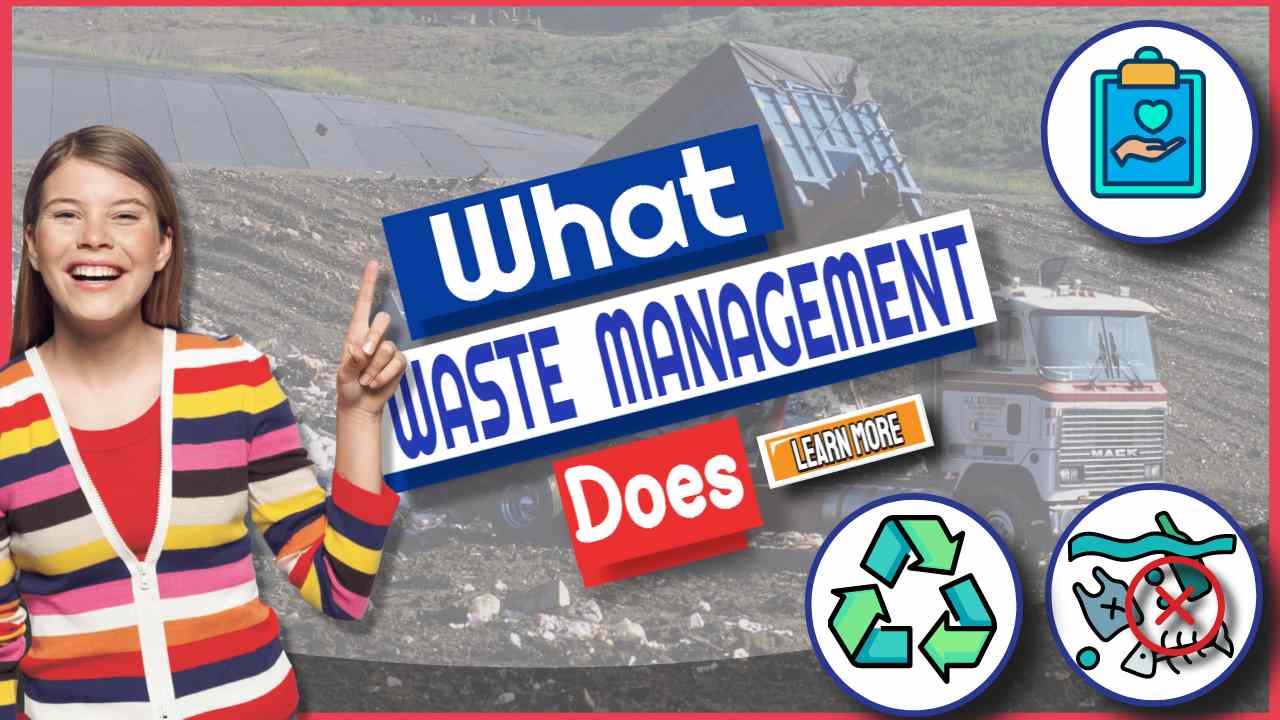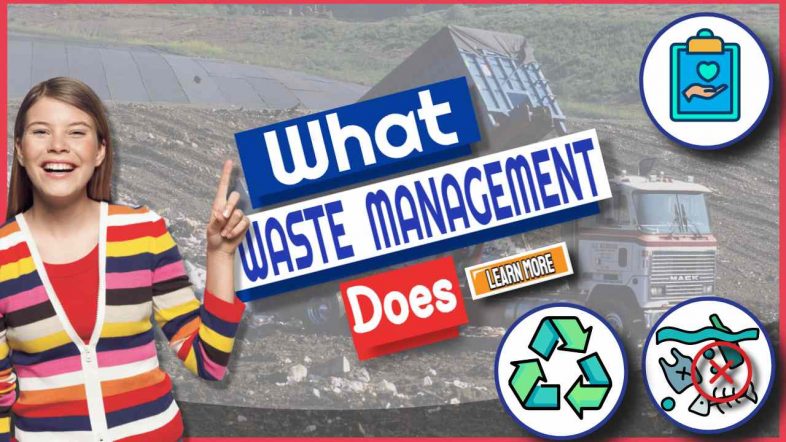What Waste Management Does – Is where lies a number of queries. This article sets out to answer the first one of definition, before moving on to explain the industry sectors and the industry's wide scope of activity types. Starting with our definition:
Waste Management Definition – What is Waste Management?
Waste management refers to the different disposal strategies and activities adopted in the responsible management of all waste. It is carried out by applying a Waste Hierarchy which dictates the principle of maximum sustainability is applied to all its activities. It can be done (in order of least to highest sustainability) by trash disposal (landfill storage), destruction (incineration), processing, recycling, reuse, and controlling waste to minimize its production and prevent hazards. The primary goal of waste management is to decrease the amount of waste by applying principles of the circular economy and to avoid any health and environmental concerns.
On This Page
- What Waste Management Does for Us All
- Waste Disposal and Recycling Collectively Known as Waste Management
- Waste Management or Circular Economy Enablers?
- Waste Management in Developing Countries
- What is Environmentally Sound Waste Management?
- What are the Many Forms of Waste Management?
- What are the Methods for Solid Waste Management?
- What are the Most Common Forms of Waste Management?
- What Waste Management FAQs
- What Waste Management Does After Public Events Natural Disasters Civil Unrest Etc
- Biowaste Management
- What Waste Management Should I be Doing?
- The 3 Rs of Waste Management
- Composting
- History of Waste Management
- Waste Transfer Stations by Waste Management Inc.
- What are the Benefits of Solid Waste Management
What Waste Management Does for Us All
In any municipality, the waste management function is the responsibility of the government. The solid waste department is responsible for ensuring the residents receive a high level of service for the collection of residential waste and overseas commercial trash services in-house or these services delivered by private businesses. Recycling and vegetation pick up is also normally the responsibility of the Solid Waste Management Department (WM). WM services are contracted to provide customer service at the lowest possible cost to the residents. This division provides guidance, oversight, and managerial support.
Waste management may be described as all of the actions necessary to manage waste, from collection through recycling and monitoring. Waste in the WM industry refers to undesirable or useless material created by human activities and can take several forms.
Waste can be liquid, solid, or gas, with each having its own disposal technique and manner of Waste Management. All states should be committed to reducing and recycling waste wherever possible, and safely managing what remains. The state program should also provide permitting and regulatory oversight for major industrial facilities
Waste Disposal and Recycling Collectively Known as Waste Management
Waste Management professionals oversee the management of solid waste while respecting the environment and the communities they serve. In a nutshell. Waste managers manage all aspects of solid waste disposal.
Employees in WM companies are highly qualified, trained and well-supported These companies have decades of experience handling even the most complex hazardous waste streams. As a result, they can ensure indemnification and compliance with all regulations related to consolidating WM functions.
A solid waste management district (SWMD) is the authority for recycling, yard trash, and household hazardous waste (HHW) services in a local county. An SWMD keeps track of materials that are recycled, processed, or disposed of (placed in landfills or incinerated). It also organises recycling and home hazardous trash collection events, as well as community outreach and education.

Waste Management or Circular Economy Enablers?
Although Waste Management (WM) is still very much an active profession, it is a discipline in transition. The climate crisis and much more public and government appreciation of environmental issues have meant that WM is now at the heart of the concept of a sustainable “circular economy”. The circular economy implies that waste production has to be reduced to a far smaller scale than it represents currently. This is essential to conserve finite resources, and even where resources are abundant to reduce man's impact.
Recycling and waste management should be integrated into a resource management system. If this management system works the presence of much waste will be minimal.
When recycling programmes first became available in the 1970s and 1980s, they were viewed as an extension of the solid waste collection system. Recycling programmes, like kerbside food waste collection systems, were supposed to pay their expenses through user fees or municipal taxes. This frequently resulted in recycling programme expenses and profits being absorbed into the entire trash collection system, and cost data have been opaque to many as a result. Even when increased recycling resulted in a reduction in overall system costs, particularly where disposal prices were high the public has seen no direct benefit flowing to them for their efforts to separate and segregate their rubbish.
All nations and communities should consider creating a WM hierarchy that prioritises sustainable procedures. Priorities like reusing and recycling above landfill disposal should be decided first before you design your waste management practices:
- Reduce: Begin by determining where your facility's trash creation may be reduced. You may realise that more material is entering your facility than is required. Consider strategies to reduce your sourcing and reduce the quantity of trash you create.
- Reuse
- Recycle.
WM in Developing Countries
Waste management (WM) is a serious issue in many developing countries, owing to a lack of funding and recycling infrastructure. Skilled staff are lacking and the legal framework to raise taxes to manage the waste, and find and penalise fly-tipping is often lacking.
For example in Sub-Saharan Africa, it was projected in 2010 that 4. 4 million tonnes of solid waste were “mismanaged” across the continent.
At the same time, it is critical to recognise that responsible waste management, comprises a number of steps, including:
- collection and storage,
- transport,
- sorting,
- treatment,
- material recovery, and
- disposal of the residues to landfill or incineration.
This is logistically complex and requires substantial investment in and maintenance of suitable infrastructure. Once in place that infrastructure needs to be manned and operated on a daily basis. This is a demanding task. There Is no stopping the public from creating waste if a waste treatment facility malfunctions, staff go on strike, or any one of a host of factors prevents the system from working as intended.
The department's regulatory activities in solid waste, hazardous waste, and asbestos are administered in step with the authorities published policy as outlined in the WM programme. In addition, there is a need for an agency that is in charge of coordinating the state's solid waste recycling activities.
What is Environmentally Sound Waste Management?
According to the World Bank Urban Development specialist and main author of the “What a Waste 2. 0 Report”, environmentally responsible waste management affects very many important elements of development. However, when it comes to designing sustainable, healthy, and inclusive cities and communities, solid WM is frequently inadequately considered.
Governments must move quickly to solve WM issues for the sake of their citizens and the planet.
The waste management hierarchy is designed to serve as a guideline to help both individuals and organisations better understand the WM process; however, only portions of this approach will apply to your actual waste management practices. As a general rule, the higher you climb the pyramid, the more power you are likely to wield. Preventing and reusing possible waste items, for example, is a straightforward and low-cost approach to decrease your total environmental effect.
What are the Many Forms of Waste Management?
There are many classifications of waste:
- Solid
- Liquid
- That decomposes (biodegradable)
- That is not biodegradable
- Non-hazardous
- Hazardous
- Inert
- Clinical
- Radioactive
- and many more.
In fact, describing any waste may invoke multiple of the above descriptions. Experts have endeavoured to formalise lists like the above for all kinds of waste materials in order to ensure that the correct WM action is applied to the handling and disposal of each and every waste.
What are the Methods for Solid WM?
The following techniques are used to handle solid waste:
- Composting,
- Ploughing into the fields, and
- Incineration
- and many more.
What are the Most Common Forms of WM?
There are several forms of waste management, some of which are described below:
- Solid waste
- Biological waste,
- Hazardous Waste
- Clinical and Anatomical
- Electrical and electronic
- Liquid waste.
There are several benefits to establishing a waste management strategy, particularly for construction businesses. Here are some of the most significant advantages:
- When customers and contractors know what trash will be generated and how much will be generated,
- they can arrange recycling and reuse services appropriately, ensuring waste that can be better handled is.
This is vastly superior to landfill, which is the least sustainable as it emits greenhouse gases and contributes to climate change. Plus it is only “waste storage” and not really “disposal” at all.
Infectious Waste
What you should know is that large-quantity producers of infectious waste create more than 100 kilos (or around 220 pounds) of infectious trash in a month. Big-scale medical institutions, such as hospitals, medical schools, large clinics, labs, or medical research centres, are most likely the generators. Solid WM rules provide these producers with choices for infectious waste handling.
What Waste Management FAQs
What should we do with the garbage we produce? What are the chances of recycling materials during a building renovation or demolition? Should materials be disposed of in landfills or converted into energy-from-waste (EfW) facilities? How can we put in place a programme that converts food waste and other biodegradable trash into sustainable energy? Can a city's WM system handle the increasing volume of electronic trash?
What WM Does After Public Events Natural Disasters Civil Unrest Etc
Almost every occurrence of large public events, natural and man-made disasters, civil unrest etc., generates trash, general garbage, and spoilt materials. While the amount of garbage created varies across events, it is frequently larger than the amount of rubbish that many towns handle each year.
Furthermore, homeland security incidents may create waste streams such as chemical, biological, and radiological-contaminated pollutants, which are not normally managed by communities or waste management institutions.
In addition to assisting the whole community in preparing for these possible wastes, pre-event planning includes source reduction and hazard mitigation actions aimed at lowering the overall quantity of trash created by an incident, particularly in the case of a large-scale natural catastrophe.
Biowaste Management
Aside from avoiding greenhouse gas emissions by creating biogas fuel, the most important benefit of effective bio-waste management by using the anaerobic digestion process would be the creation of high-quality compost and biogas. Both compost and the output from biogas plants contribute to improved soil quality. Biogas digesters and composting add to resource efficiency, as well as providing a greater degree of energy self-sufficiency.
In reality, however, many states are frequently tempted to forego composting or biogas generation in favour of the ostensibly easiest and cheapest alternatives in the short term, such as incineration or landfilling. This ignores the true environmental advantages and costs advantages of anaerobic digestion technology.
What Waste Management Should I be Doing?
Many people ask “What Waste Management Should I be Doing?” Read on and we will offer you our ideas on that score.
1. Minimize
Try to avoid waste in the first place. Can you, for instance, food shop more carefully and avoid waste by planning out the week's meals before you go shopping.
2. Reuse or repair anything you can
Households and companies are encouraged to first investigate whether they can reuse or repair anything before tossing it away and replacing it with a new one.
This is true, for example, of electronics, clothing, and furnishings. Employers may encourage staff to reuse goods, reducing waste production while also saving money.
Instead of tossing away used items, consider donating or selling them.
3. Recycle
Recycling is the process of converting trash into new goods. Recycling aims to minimise energy consumption, limit the need for new raw materials, and therefore protect natural resources. It also reduces the usage of landfills, water and air pollution, and the production of many forms of hazardous gases. The main one of these is methane.
Recycling is a component of resource recovery in which natural resource extraction is limited and the focus of the product or material design is on sustainability, durability, reuse, and recycling.
The 3 Rs of Waste Management
The 3 Rs, which stand for “reduce,” “reuse,” and “recycle,” were created in the late 1970s to provide the public with a guideline for decreasing trash. The objective was to minimise trash generation while also assisting governments in WM skills.
Composting
Composting is a WM strategy that is a natural process that accelerates the breakdown of organic materials such as kitchen trash, plant waste, and garden waste. Microbes are essential to the process, and in order for these microorganisms to grow, a perfect habitat with the proper temperatures, moisture, and oxygen is required.
This procedure produces nutrient-rich soil, which is then utilised to grow crops, plants, and trees. Composting is frequently utilised in organic farming. Composting is a reasonably safe technique of waste disposal that may simply be employed for domestic waste management. One downside is that because it is a natural process, it takes time, and, like landfills, this technique takes up a lot of land area.
History of Waste Management
The quantity of trash created by people has varied throughout history. In Europe, a sharp increase was caused by industrialization, which was accompanied by an expansion in urban population. Waste in the streets began to pile up as a result of a lack of clearing laws, threatening the cleanliness and health of the urban population.
Following cholera epidemics in England in the mid-nineteenth century, social reformer Edwin Chadwick issued a study titled “The Sanitary Condition of the Labouring Population.” He wrote on the necessity for adequate trash removal and management facilities in this study in order to promote the population's health and well-being. This resulted in the enactment of the ‘Nuisance Removal and Disease Prevention Act' in 1846. Following this legislation, the Public Health Act 1975 was enacted, making it mandatory for homes to utilise a “dust-bin” for weekly trash disposal.
Waste Transfer Stations by Waste Management Inc.
WM Inc. operates Waste Transfer Stations where garbage and recycling pickup services, as well as dumpster rentals, are available for residents, businesses, and industries. Transfer stations serve as an intermediary collecting point for local trash trucks before transporting waste to regional landfills.
What are the Benefits of Solid WM (SWM)
Solid Waste Management is a discipline that uses management skills to apply national and international waste collection, sorting, treatment and ultimately also disposal of all a nations “waste” (unwanted outputs from all activities).
Where a community applies regulations both legal and fiscal to ensure the population complies with a set of waste regulations solid waste management professionals apply systems to achieve the following benefits:
- Health: Waste is collected and removed in a manner that prevents vectors of disease in the waste or which may develop in the waste over a period of time causing a health hazard.
- Safety: Waste is removed from public spaces (and subject to contractual responsibilities) other spaces where it may impede or form an obstacle, trip hazard etc., to cause an injury risk.
- Environment: Both the local environment and global environmental interests are as far as possible protected, through such measures as engineered (lined and capped landfills) and flaring of greenhouse gas emissions.
- Social: Odours and noise pollution are minimized.
- Economic: Applying good waste management practice which follows the Waste Hierarchy ensures the best use of resources making economies more viable, and raising overall wealth in the population while protecting future generations from inter-generational economic burdens.







